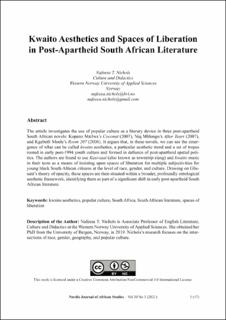Kwaito Aesthetics and Spaces of Liberation in Post-Apartheid South African Literature
Peer reviewed, Journal article
Published version
Permanent lenke
https://hdl.handle.net/11250/2984667Utgivelsesdato
2021Metadata
Vis full innførselSamlinger
Originalversjon
Nichols, N. T. (2021). Kwaito aesthetics and spaces of liberation in post-apartheid South African literature. Nordic Journal of African Studies, 30(3). 10.53228/njas.v30i3.805Sammendrag
The article investigates the use of popular culture as a literary device in three post-apartheid South African novels: Kopano Matlwa’s Coconut (2007), Niq Mhlongo’s After Tears (2007), and Kgebetli Moele’s Room 207 (2006). It argues that, in these novels, we can see the emergence of what can be called kwaito aesthetics, a particular aesthetic trend and a set of tropes rooted in early post-1994 youth culture and formed in defiance of post-apartheid spatial politics. The authors are found to use Kasi-taal (also known as township slang) and kwaito music in their texts as a means of insisting upon spaces of liberation for multiple subjectivities for young black South African citizens at the level of race, gender, and culture. Drawing on Glissant’s theory of opacity, these spaces are then situated within a broader, profoundly ontological aesthetic framework, identifying them as part of a significant shift in early post-apartheid South African literature.

